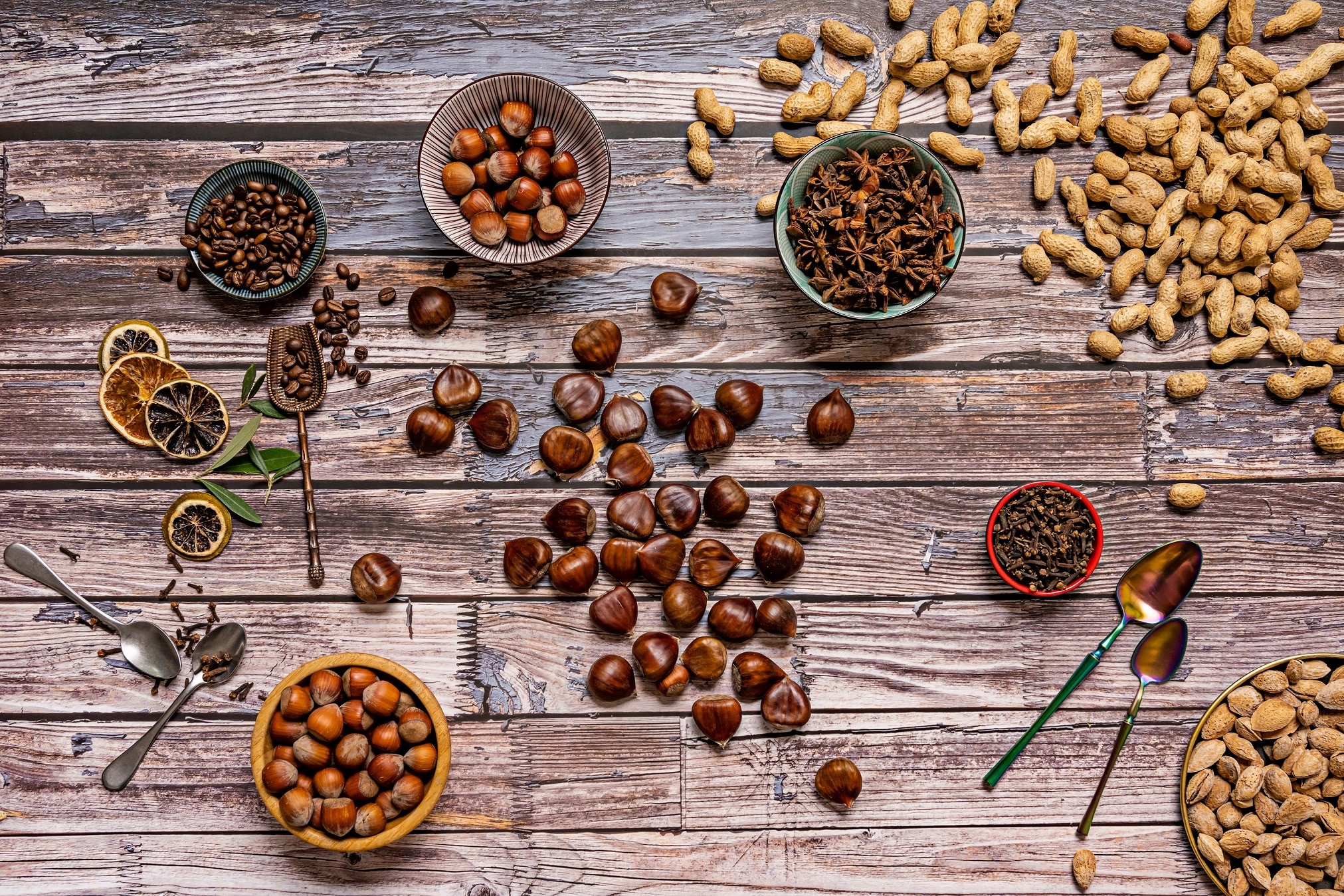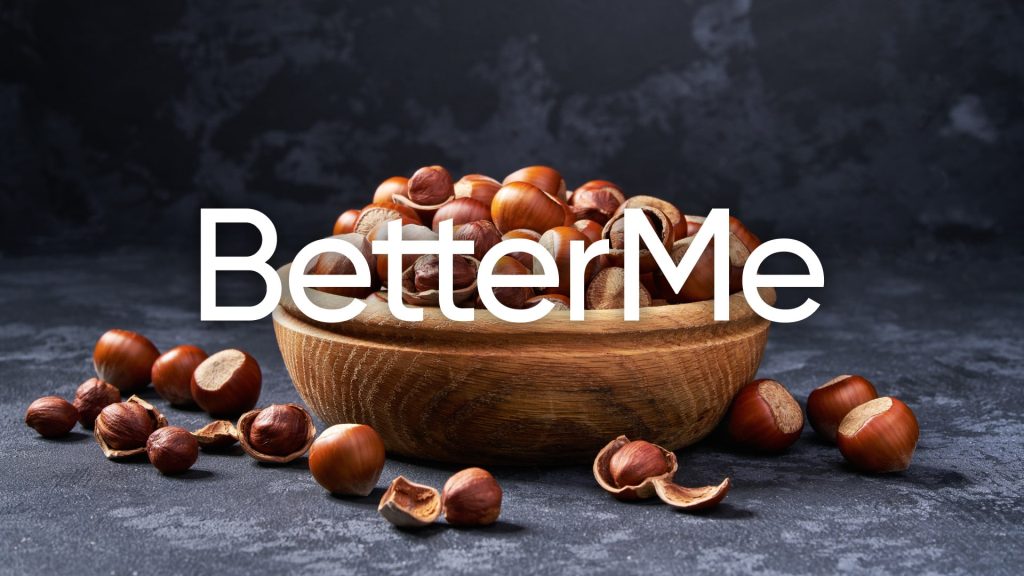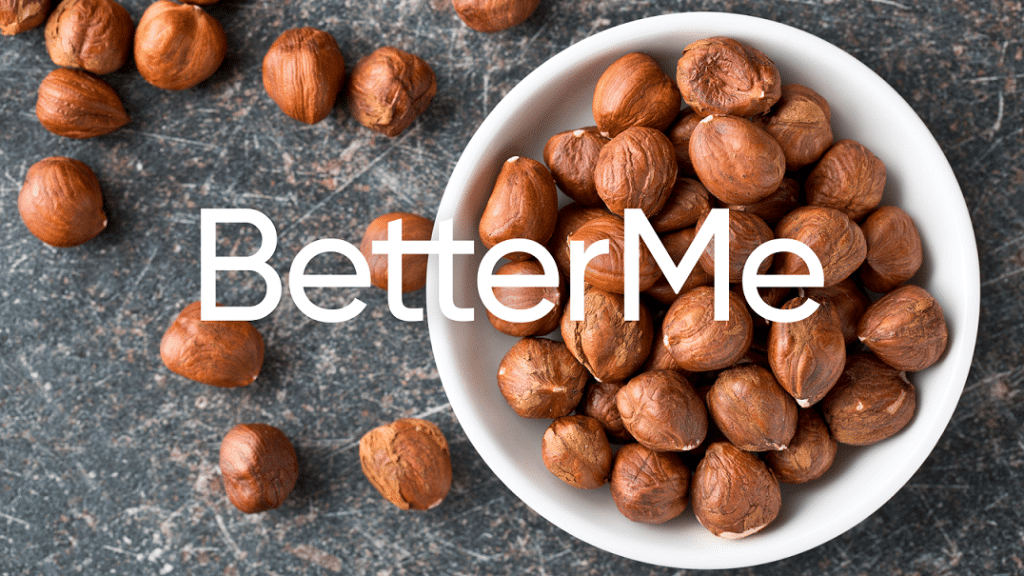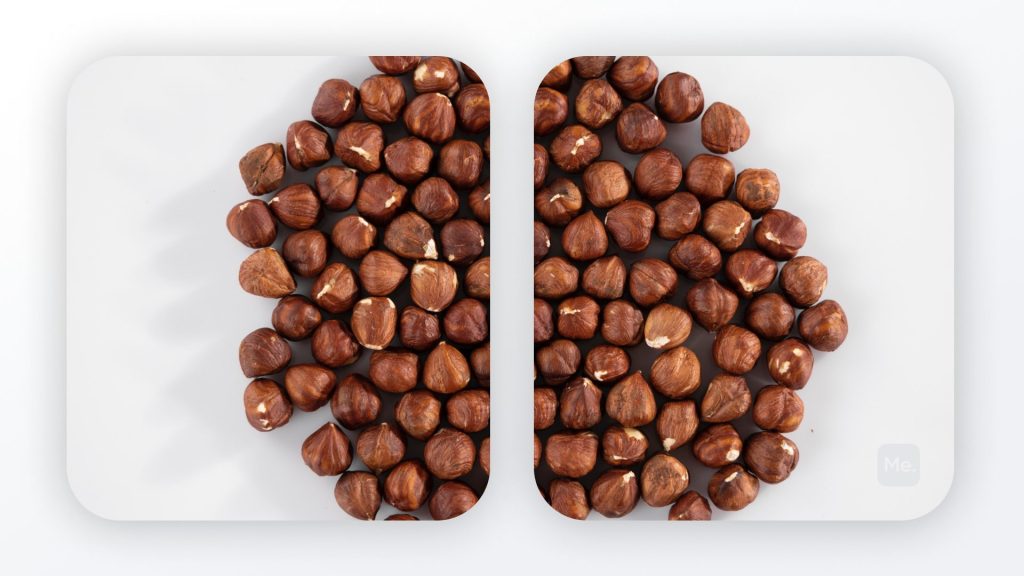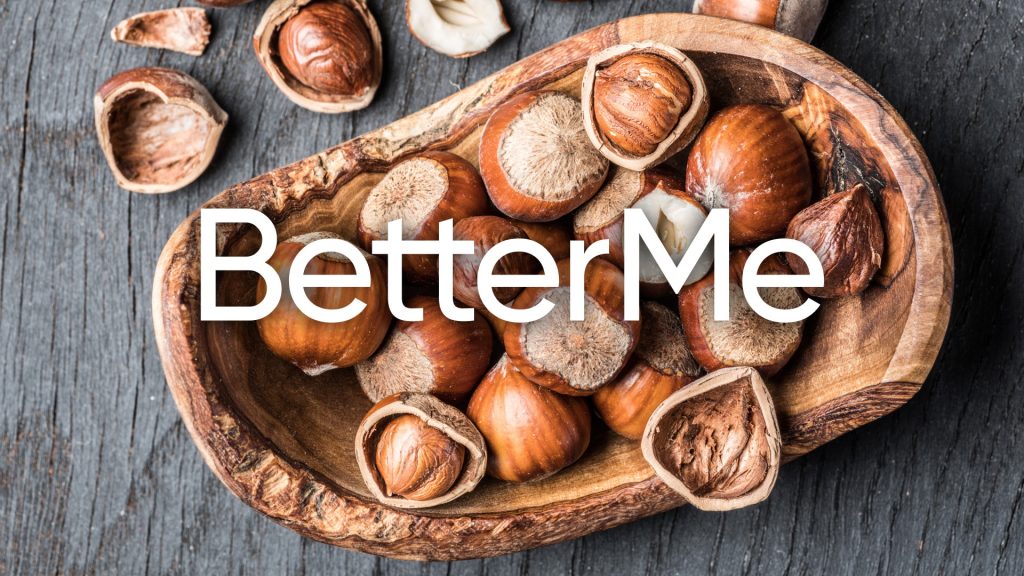Chestnuts and hazelnuts are similar in many ways. For one, both nuts provide a healthy dose of nutrients, including protein, fiber, thiamine (vitamin B1), riboflavin (B2), folate (B9), magnesium, potassium and copper. That said, there are some key differences between these two nuts that may make one more desirable than the other depending on your needs. In this article, we’ll compare the nutritional value, health benefits, and possible side effects of chestnuts and hazelnuts.
Get your personalized
meal plan!
Chestnut Nutrition Facts
100 grams of chestnuts contains the following nutrients (6):
- Calories – 245
- Carbohydrates – 45.54 g
- Fat – 2.26 g
- Dietary fiber – 5.1 g
- Protein – 3.17g
- Calcium – 29 mg
- Iron – 1.01 mg
- Magnesium – 32 mg
- Phosphorus – 93 mg
- Potassium – 518 mg
- Zinc – 0.52 mg
- Vitamin B1 (Thiamine) – 0.238 mg
- Vitamin B2 (riboflavin) – 0.168 mg
- Vitamin B3 (Niacin) – 1.179 mg
- Vitamin B5 – 0.509 mg
- Vitamin B6 – 0.376 mg
- Vitamin B9 (Folic acid) – 62 mg
- Vitamin C – 43 mg
Hazelnut Nutrition Facts
100 grams of hazelnuts contains the following nutrients (11):
- Calories – 628
- Carbohydrates – 16.7 g
- Fat – 60.75 g
- Dietary fiber – 9.7 g
- Protein – 14.95 g
- Calcium – 114 mg
- Iron – 4.7 mg
- Magnesium – 163 mg
- Phosphorus – 290 mg
- Potassium – 680 mg
- Zinc – 2.45 mg
- Vitamin B1 (Thiamine) – 0.643 mg
- Vitamin B2 (riboflavin) – 0.113 mg
- Vitamin B3 (Niacin) – 1.8 mg
- Vitamin B5 – 0.918 mg
- Vitamin B6 – 0.563 mg
- Vitamin B9 (Folic acid) – 113 mg
- Vitamin C – 6.3 mg
Read More: Hazelnuts Facts, Calories, Health Benefits And Side Effects
Comparison Of Hazelnut Vs Chestnut Health Benefits
Heart Health
Both chestnuts and hazelnuts seem to have similar health benefits for the heart. The fat content in these nuts is primarily unsaturated, which provides a healthier composition than other fatty foods (9).
Additionally, both chestnuts and hazelnuts provide a decent amount of monounsaturated fats or omega 3 fatty acids. Both of these components are known as “good” fats that can help lower our bad cholesterol levels (9).
Chestnuts and hazelnuts also contain antioxidants, which can protect our blood vessels from damage. This can help keep our heart functioning optimally and may even reduce our risk of developing heart disease (9).
Brain Health
Both chestnuts and hazelnuts are good sources of B vitamins, including thiamine, riboflavin, and niacin. These vitamins are essential for brain health, as they help to maintain the structure and function of our cells. In addition, B vitamins are known to help support cognitive function and memory (4).
Chestnuts also contain vitamin C, which is important for brain health. Vitamin C is a powerful antioxidant that can protect our cells from damage. It may also help to delay age-related cognitive decline (3).
Skin Health
Chestnuts and hazelnuts are both good sources of vitamin E, which is beneficial for skin health. Vitamin E is an antioxidant that helps to protect our cells from damage. It may also help to reduce the signs of aging, such as wrinkles and age spots (14).
In addition, chestnuts contain copper, which is necessary for the production of collagen. Collagen is a protein that helps maintain the elasticity and strength of our skin (7). Hazelnuts also contain selenium, which is another antioxidant that can help protect our skin from sun damage (9).
Weight Loss
Although chestnuts and hazelnuts are high in calories, they can both help promote weight loss. This is because they are a good source of fiber, which can help us feel full after eating them. In addition, chestnuts and hazelnuts contain a high amount of monounsaturated fats. These fats are known to help reduce body fat levels and promote weight loss when incorporated into a healthy balanced diet (9).
Cancer Prevention
Both chestnuts and hazelnuts contain antioxidants, which can help protect our cells from damage. This may help reduce our risk of developing cancer (9). In addition, chestnuts contain lutein and zeaxanthin. These compounds are known to help protect our eyes from damage and eye conditions that tend to develop as we age (10).
Boost Immune System
Chestnuts and hazelnuts are both good sources of vitamin C, which is important for immune system health. Vitamin C is a powerful antioxidant that can help protect our cells from damage. It may also help support our immune system and help us fight off infection (13).
Ease Menstrual Symptoms
Chestnuts are a good source of magnesium, which may help to ease menstrual symptoms. Magnesium is a mineral that helps to regulate the release of hormones. It might also help to reduce pain and cramping during menstruation (8).
Hazelnuts also contain vitamin B6, which may help to relieve PMS symptoms, especially in combination with magnesium. Vitamin B6 is a vitamin that helps to regulate our moods and emotions. It can also help to reduce pain and inflammation (8).
BetterMe is your fast-track ticket to a long-lasting weight loss! Tailor your fitness journey and maximize your results with just a couple of swipes!
Pregnancy Benefits
Chestnuts are a good source of folate, which is important for pregnant women. Folate is a vitamin that helps to prevent birth defects in the baby. It is necessary for the development of the neural tube. Hazelnuts also contain vitamin E, which is beneficial for pregnant women. Vitamin E is an antioxidant that helps to protect our cells from damage. It may also help reduce the risk of developing pregnancy complications (9).
Comparison Of Hazelnut Vs Chestnut Side Effects
Chestnuts and hazelnuts are both considered safe to eat, but there are a few potential side effects that may occur.
Chestnuts may cause an allergic reaction in some people. Symptoms of an allergic reaction can include itchiness, hives, swelling, and difficulty breathing (5).
Hazelnuts may also cause an allergic reaction in some people. Additionally, hazelnuts contain a high amount of oxalates. Oxalates are naturally occurring chemicals that can bind to calcium in the body. This can cause problems such as kidney stones or gout flare-ups in those who are prone to them (2).
So Which Is Better For You? Chestnut Or Hazelnut?
It really depends on what you are looking for in a nut. Both chestnuts and hazelnuts have a number of health benefits.
Hazelnuts are a good source of B vitamins, vitamin E, and copper, which are all beneficial for skin health. They also contain selenium, an antioxidant that can help protect our skin from damage (1).
Chestnuts seem to be especially good for heart health, as they are high in unsaturated fats and contain thiamine, riboflavin, niacin, vitamin C, and vitamin E. These components work together to lower bad cholesterol levels and promote weight loss (12).
So which is better overall? Both. Nutritionally speaking, both chestnuts and hazelnuts can provide many benefits. Chestnuts are high in antioxidants, vitamins, and minerals. Hazelnuts are a good source of fiber and monounsaturated fats, which can help promote weight loss (12).
Chestnuts also make for a great snack or addition to salads or soups. Hazelnut butter can also be used instead of peanut butter on sandwiches or smoothies (yum!).
At the end of the day though, it’s not really about competition. Both chestnuts and hazelnuts can be part of a healthy diet. If you like nuts, include them both!
Read More: Are Pistachios Good For Weight Loss? Find Out Whether These Tree Nuts Should Be In Your Diet
How To Eat Chestnuts And Hazelnuts
Both chestnuts and hazelnuts have a high fat content. Because of this, they are energy-dense and so best eaten in moderation.
Chestnuts can be roasted on an open flame or in the oven. They can also be boiled, steamed, or microwaved. Hazelnuts can be eaten raw or roasted. They can also be used in baking recipes, as a topping for salads, or as a spread on toast or sandwiches.
Here are some tips for eating these nuts as part of a balanced diet that doesn’t result in weight gain:
Avoid Adding Salt Or Sugar
Chestnuts and hazelnuts are both high in fat, which means they may be easy to overindulge on. This is especially true if you’re eating them straight out of the bag or using them as a topping for sweet dishes.
To avoid this, try not to add salt or sugar when preparing these nuts. You may also want to use smaller quantities than you normally would (for example, only eat one handful at a time). This will help to cut down on calories without making you feel deprived of your favorite foods!
Eat Them Alongside Protein And Fiber-Rich Foods
Both chestnuts and hazelnuts are high in fat, so it’s important to consider what you eat with them. For the best blood sugar balance, try eating nuts along with protein-rich foods like beans or lean meat. This will slow down how quickly your body absorbs the nutrients from both sources. Fiber-rich foods will do the same thing, as they help to regulate your digestive system.
If you’ve mustered up the courage to crush your weight loss goal, let Betterme take the sting out of this demanding process. Our app will help you restructure your habits, remold your life and crank up your fitness results!
Eat Them Instead Of Processed Snacks
Both chestnuts and hazelnuts can be a healthy and filling substitute for processed snacks. But again, you’ll want to consume them in moderation if they are to be eaten as part of a balanced diet. A recommended serving of nuts is 1 ounce or a small handful. If you do eat them as a snack, try pairing them with fiber-rich foods like vegetables or fruit. This will help cut down on calories without sacrificing nutrients.
The Bottom Line
Overall, it seems that both chestnuts and hazelnuts have a number of health benefits that can improve our overall health. Which one is best for you will depend on your individual dietary needs and preferences. However, either one is a good choice for a healthy snack or addition to your diet.
DISCLAIMER:
This article is intended for general informational purposes only and does not serve to address individual circumstances. It is not a substitute for professional advice or help and should not be relied on for making any kind of decision-making. Any action taken as a direct or indirect result of the information in this article is entirely at your own risk and is your sole responsibility.
BetterMe, its content staff, and its medical advisors accept no responsibility for inaccuracies, errors, misstatements, inconsistencies, or omissions and specifically disclaim any liability, loss or risk, personal, professional or otherwise, which may be incurred as a consequence, directly or indirectly, of the use and/or application of any content.
You should always seek the advice of your physician or other qualified health provider with any questions you may have regarding a medical condition or your specific situation. Never disregard professional medical advice or delay seeking it because of BetterMe content. If you suspect or think you may have a medical emergency, call your doctor.
SOURCES:
- A Hazelnut-Enriched Diet Modulates Oxidative Stress and Inflammation Gene Expression without Weight Gain (2019, nih.gov)
- Available oxalate content of nuts (2006, researchgate.net)
- Brain foods: the effects of nutrients on brain function (2010, nih.gov)
- B Vitamins and the Brain: Mechanisms, Dose and Efficacy-A Review (2016, nih.gov)
- Chestnut allergy (2003, jacionline.org)
- Chestnuts (2020, usda.gov)
- Copper and the synthesis of elastin and collagen (1980, pubmed.gov)
- Evaluating the effect of magnesium and magnesium plus vitamin B6 supplement on the severity of premenstrual syndrome (2010, nih.gov)
- Health Benefits of Nut Consumption (2010, nih.gov)
- Lutein plus Water Chestnut (Trapa bispinosa Roxb.) Extract Inhibits the Development of Cataracts and Induces Antioxidant Gene Expression inLens Epithelial Cells (2020, hindawi.com)
- Nuts, hazelnuts or filberts (2019, usda.gov)
- Uses and health benefits of chestnuts (2019, researchgate.net)
- Vitamin C (2021, nih.gov)
- Vitamin E in dermatology (2016, nih.gov)
